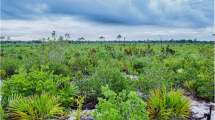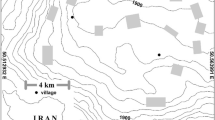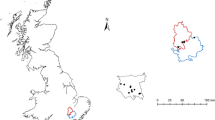Abstract
Changes in the ground flora in sweet chestnut (Castaneasativa) woodland were studied over 11 years usingpermanent quadrats in two coppiced plots and one plot in a ride widened by treeremoval. Light and temperature were also recorded. The temperature range wasgreater in the ride than in the coppice plots. Light reaching the woodland floorin summer fell to less than 1% of incident radiation at later stages of thecoppice cycle. Species richness peaked in the second and third year aftercoppicing and then declined in both the coppice plots and the ride. A similarpattern was seen in total percentage frequency of cover. The dominant species,Anemone nemorosa, showed little response to the coppicecycle in terms of frequency, but showed a fourfold increase in floweringintensity in the second and third year following coppicing. Other speciesgenerally declined in frequency through the coppice cycle, and flowering waslargely suppressed in the later stages. The results are discussed in relation toalternative methods of woodland management.
Similar content being viewed by others
References
Adamson R.S. 1912. An ecological study of a Cambridgeshire woodland. Journal of the Linnaean Society (Botany) 40: 339–387.
Allen S.E., Grimshaw H.M., Parkinson J.A., Quarmby C. and Roberts J.D. 1976. Chemical analysis. In: Chapman S.B. (ed.), Methods in Plant Ecology. Blackwell, Oxford, UK, pp. 411-466.
Ash J.E. and Barkham J.E. 1976. Changes and variability in the field layer of a coppiced woodland in Norfolk, England. Journal of Ecology 64: 697–712.
Asher J., Warren M., Fox R., Harding P., Jeffcoate G. and Jeffcoate S. 2001. The Millennium Atlas of Butterflies in Britain and Ireland. Oxford University Press, Oxford, UK.
Barkham J.P. 1992a. The effects of management on the ground flora of ancient woodland, Brigsteer Park Wood, Cumbria, England. Biological Conservation 60: 167–187.
Barkham J.P. 1992b. The effects of coppicing and neglect on the performance of the perennial ground flora. In: Buckley G.P. (ed.), Ecology and Management of Coppice Woodlands. Chapman & Hall, London, pp. 115–145.
Ford E.D. and Newbould P.J. 1977. The biomass and production of ground vegetation and its relation to tree cover through a deciduous woodland cycle. Journal of Ecology 65: 201–212.
Fuller R.J. and Moreton B.D. 1987. Breeding bird populations of Kentish sweet chestnut Castanea sativa coppice in relation to age and structure of the coppice. Journal of Applied Ecology 24: 13–27.
Gondard H., Romane F., Grandjanny M., Li J. and Aronson J. 2001. Plant species diversity changes in abandoned chestnut (Castanea sativa) groves in southern France. Biodiversity and Conservation 10: 189–207.
Hill D., Roberts P. and Stork N. 1990. Densities and biomass of invertebrates in stands of rotationally managed coppice woodland. Biological Conservation 51: 167–176.
Martin M.H. and Martin R.M. 1993. The effects of coppicing on the vegetation of the field and ground layers of an ancient woodland, LowerWetmoorWood. Proceedings of the Bristol Naturalists' Society 53: 73–84.
Mason C.F. 2001.Woodland area, species turnover and the conservation of bird assemblages in lowland England. Biodiversity and Conservation 10: 495–510.
ason C.F. and Long S.P. 1987. Management of lowland broadleaved woodland: Bovindon Hall, Essex. In: Matthews R. (ed.), Conservation Monitoring and Management. Countryside Commission, Cheltenham, UK, pp. 37–42.
Peterken G.F. 1981. Woodland Conservation and Management. Chapman & Hall, London.
Peterken G.F. 1996. Natural Woodland. Cambridge University Press, Cambridge, UK.
Rackham O. 1975. Hayley Wood: Its History and Ecology. Cambridgeshire and Isle of Ely Naturalists' Trust, Cambridge, UK.
Rackham O. 1976. Trees and Woodland in the British Landscape. Dent, London.
Rackham O. 1980. Ancient Woodland: Its History, Vegetation and Uses in England. Edward Arnold, London.
Salisbury E.J. 1924. The effects of coppicing as illustrated by the woods of Hertfordshire. Transactions of the Hertfordshire Natural History Society 18: 1–21.
Shirreffs D.A. 1985. Biological flora of the British Isles no. 158, Anemone nemorosa L. Journal of Ecology 73: 1005–1020.
Stace C. 1997. New Flora of the British Isles. 2nd edn. Cambridge University Press, Cambridge, UK.
Warren M.S. and Fuller R.J. 1990.Woodland Rides and Glades: Their Management for Wildlife. Nature Conservancy Council, Peterborough, UK.
Author information
Authors and Affiliations
Rights and permissions
About this article
Cite this article
Mason, C.F., MacDonald, S.M. Responses of ground flora to coppice management in an English woodland – a study using permanent quadrats. Biodiversity and Conservation 11, 1773–1789 (2002). https://doi.org/10.1023/A:1020395014155
Issue Date:
DOI: https://doi.org/10.1023/A:1020395014155




